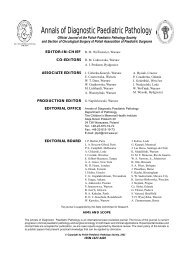annals 1-2.qxd - Centrum Zdrowia Dziecka
annals 1-2.qxd - Centrum Zdrowia Dziecka
annals 1-2.qxd - Centrum Zdrowia Dziecka
Create successful ePaper yourself
Turn your PDF publications into a flip-book with our unique Google optimized e-Paper software.
44<br />
pulation and occur mostly in older children and adolescents<br />
[12]. We report herein a rare case of 16-year-old girl with<br />
a composite tumor (paraganglioma with neuroblastoma<br />
component) located in the retroperitoneal space.<br />
Case report<br />
A 16-year-old girl was referred to the Department of Oncology<br />
in Szczecin, Poland for the treatment of the retroperitoneal<br />
tumor. She had 2-year history of periodic, recurrent abdominal<br />
pain managed with spasmolythic agents. She did not<br />
have any additional complaints. On physical examination she<br />
was in good general condition, antropometrically presenting<br />
short height, and slightly disturbed body proportions (long<br />
body corpse and short extremities) similar to her mother. Her<br />
blood pressure and glycemia was normal, she did not have<br />
any episodes of vomiting, hypertension, or tachycardia. On<br />
physical examination there was an ill- defined, slightly tender,<br />
non-movable mass over the left side of her abdomen.<br />
Abdominal ultrasonography revealed left paraspinal mass,<br />
with intensive vascularity and mixed echogenicity. Fine needle<br />
aspiration biopsy detected atypical cells. Contrast enhanced<br />
computed tomography of the abdomen revealed a left<br />
retroperitoneal tumor (65 mm × 46 mm × 90 mm) below the<br />
pancreatic tail, attached to aorta and reaching aortic bifurcation.<br />
The mass was well defined, good vascularized, a pressure<br />
effect on the left illiopsoas muscle and lower pole of the<br />
left kidney was seen. The tumor displaced left renal, splenic<br />
and lower mesenteric vessels. There was no extension in the<br />
vertebral foramina (Fig. 1A, Fig. 1B).<br />
During induction to general anaesthesia, she had an<br />
episode of circulatory-respiratory collapse with pulmonary<br />
oedema. Using epidural analgesia, core needle biopsy of the<br />
tumor was performed, and the specimen was delivered for<br />
hematoxylin/eosin staining as well as for immunohistochemical<br />
studies. These studies were performed with commercially<br />
available antibodies (S-100 protein, chromogranin, sy-<br />
naptophysin, MIB-1, NSE and vimentin) and according to<br />
standard protocols. Pathological studies of the tumor revealed<br />
paraganglioma.<br />
In further diagnostic evaluation Metaiodobenzyl guanidine<br />
I 131 scintigraphy (MIBG) revealed uptake only<br />
within the tumor in left mid-abdomen with no metastasis.<br />
Laboratory data included urine catecholamine metabolites<br />
revealed increased level of vanilmandelic acid (VMA)<br />
(15,2 – 16,1 mg/24 h, N: 0,41 – 3,74). Based on these findings,<br />
pheochromocytoma or neuroblastoma was suspected.<br />
Open tumor biopsy was performed and histological evaluation<br />
revealed neuroblastoma (Fig. 2A, Fig. 2B). N-myc was<br />
not amplified in the molecular study of the tumor sample.<br />
Treatment with combination chemotherapy was executed<br />
(PACE protocol for III stage neuroblastoma: 4 preoperative<br />
cycles of vincristine, doxorubicin, cyclophosphamide and<br />
cisplatin). Tumor response for oncological treatment was<br />
judged as negative. Tumor size remained unchanged; whereas<br />
significant decrease of previously elevated level of<br />
VMA in 24-hour urine collection was noted (8,6 mg/24 h vs<br />
15,2 mg/24 h).<br />
Patient was referred to the Department of Pediatric<br />
Surgery, Collegium Medicum in Bydgoszcz, for the surgical<br />
treatment. After 3-week preoperative preparation with phenoxybenzamine<br />
patient underwent surgery. Transperitoneal<br />
approach was used for the complete removal of the tumor.<br />
Macroscopically tumor displayed hemorrhagic areas. Histopathologic<br />
study revealed paraganglioma with extensive areas<br />
of fibrosis (Fig. 3A, Fig. 3B). There was no perioperative<br />
and postoperative complications. In 2 years follow up patient<br />
remains free of disease.<br />
Discussion<br />
Composite pheochromocytomas – ganglioneuro (blasto)<br />
mas are rare composite tumors of both adrenal and extraadrenal<br />
pheochromocytomas [6]. Other non-pheochromo-<br />
A<br />
B<br />
Fig. 1<br />
A. Abdominal computed tomography revealed left retroperitoneal tumor. Preoperative study, after 4 courses of chemotherapy for neuroblastoma.<br />
B. 3-D reconstruction of a contrast enhanced abdominal CT scans provided good orientation in tumor vascularity and preoperative anatomical circumstances.

















